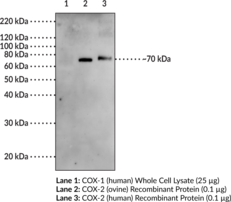Description
Retinoic acid-inducible gene I (RIG-I), also known as DDX58, is a cytosolic DExD/H-box RNA helicase and an immune sensing receptor encoded by DDX58 in humans.{48287} It is composed of a C-terminal repressor domain, a central RNA helicase domain, and two N-terminal caspase recruitment domains (CARDs).{48287,48288} Following recognition of viral dsRNA by the C-terminal and helicase domains, the helicase domain induces an ATP-dependent conformational change, allowing for interaction of the CARD domains with mitochondrial antiviral-signaling protein (MAVS) and induction of a type I interferon (IFN) response.{48287,48288,48289} RIG-I levels are elevated in the epidermis of patients with psoriasis.{48288} DDX58 expression is decreased in tumor tissues from patients with hepatocellular carcinoma (HCC) compared to nontumor hepatic tissue, and low DDX58 expression is associated with poor disease prognosis.{46559} Cayman’s RIG-I Monoclonal Antibody (Clone 1E3) can be used for Western blot, ELISA, and immunohistochemistry applications. The antibody recognizes RIG-I at 106.6 kDa from human and mouse samples.
Synonyms: DEAD Box Protein 58|Probable ATP-dependent RNA Helicase DDX58|Retinoic Acid-inducible Gene 1 Protein|RIG-I-like Receptor 1
Immunogen: Recombinant human RIG-I protein AA 232-794
Formulation: 100 µg of protein G-purified antibody
Isotype: IgG2b
Applications: ELISA, IHC, WB
Origin:
Stability: 365 days
Application|ELISA||Application|Immunohistochemistry||Application|Western Blot||Product Type|Antibodies|Monoclonal Antibodies||Research Area|Cancer||Research Area|Immunology & Inflammation|Autoimmunity||Research Area|Immunology & Inflammation|Innate Immunity|Pattern Recognition||Research Area|Immunology & Inflammation|Innate Immunity|STING||Research Area|Infectious Disease




